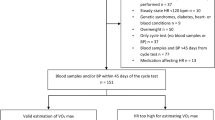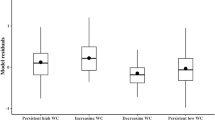Abstract
Low aerobic fitness (maximum oxygen uptake (VO2PEAK)) is predictive for poor health in adults. In a cross-sectional study, we assessed if VO2PEAK is related to a composite risk factor score for cardiovascular disease (CVD) in 243 children (136 boys and 107 girls) aged 8 to 11 years. VO2PEAK was assessed by indirect calorimetry during a maximal exercise test and scaled by body mass (milliliters per minute per kilogram). Total body fat mass (TBF) and abdominal fat mass (AFM) were measured by Dual-energy X-ray absorptiometry. Total body fat was expressed as a percentage of total body mass (BF%) and body fat distribution as AFM/TBF. Systolic and diastolic blood pressure (SDP and DBP) and resting heart rate (RHR) were measured. The mean artery pressure (MAP) and pulse pressure (PP) were calculated. Echocardiography, 2D-guided M-mode, was performed. Left atrial diameter (LA) was measured and left ventricular mass (LVM) and relative wall thickness (RWT) were calculated. Z scores (value for the individual − mean value for group)/SD were calculated by sex. The sum of z scores for DBP, SDP, PP, MAP, RHR, LVM, LA, RWT, BF%, AFM and AFM/TBF were calculated in boys and girls, separately, and used as composite risk factor score for CVD. Pearson correlation revealed significant associations between VO2PEAK and composite risk factor score in both boys (r = −0.48 P < 0.05) and in girls (r = −0.42, P < 0.05). One-way ANOVA analysis indicated significant differences in composite risk factor score between the different quartiles of VO2PEAK (P < 0.001); thus, higher VO2PEAK was associated with lower composite risk factor score for CVD. In conclusion, low VO2PEAK is associated with an elevated composite risk factor score for CVD in both young boys and girls.

Similar content being viewed by others
References
Andersen LB, Haraldsdottir J (1993) Tracking of cardiovascular disease risk factors including maximal oxygen uptake and physical activity from late teenage to adulthood. An 8-year follow-up study. J Intern Med 234:309–315
Andersen LB, Harro M, Sardinha LB, Froberg K, Ekelund U, Brage S, Anderssen SA (2006) Physical activity and clustered cardiovascular risk in children: a cross-sectional study (The European Youth Heart Study). Lancet 368:299–304
Andersen LB, Sardinha LB, Froberg K, Riddoch CJ, Page AS, Anderssen SA (2008) Fitness, fatness and clustering of cardiovascular risk factors in children from Denmark, Estonia and Portugal: the European Youth Heart Study. Int J Pediatr Obes 3(Suppl 1):58–66
Anderssen SA, Cooper AR, Riddoch C, Sardinha LB, Harro M, Brage S, Andersen LB (2007) Low cardiorespiratory fitness is a strong predictor for clustering of cardiovascular disease risk factors in children independent of country, age and sex. Eur J Cardiovasc Prev Rehabil 14:526–531
Armstrong N, van Mechelen W (eds) (2000) Paediatric exercise science and medicine. Oxford University Press, Oxford
Berenson GS, Srinivasan SR, Bao W, Newman WP 3rd, Tracy RE, Wattigney WA (1998) Association between multiple cardiovascular risk factors and atherosclerosis in children and young adults. The Bogalusa Heart Study. N Engl J Med 338:1650–1656
Boreham C, Twisk J, Murray L, Savage M, Strain JJ, Cran G (2001) Fitness, fatness, and coronary heart disease risk in adolescents: the Northern Ireland Young Hearts Project. Med Sci Sports Exerc 33:270–274
D’Agostino RB Sr, Vasan RS, Pencina MJ, Wolf PA, Cobain M, Massaro JM, Kannel WB (2008) General cardiovascular risk profile for use in primary care: the Framingham Heart Study. Circulation 117:743–753
Dencker M, Thorsson O, Karlsson MK, Lindén C, Eiberg S, Wollmer P, Andersen LB (2006) Daily physical activity related to body fat in children aged 8–11 years. J Pediatr 149:38–42
Dencker M, Thorsson O, Karlsson MK, Lindén C, Eiberg S, Wollmer P, Andersen LB (2007) Gender differences and determinants of aerobic fitness in children aged 8–11 years. Eur J Appl Physiol 99:19–26
Dencker M, Thorsson O, Karlsson MK, Lindén C, Svensson J, Wollmer P, Andersen LB (2006) Daily physical activity in Swedish children aged 8–11 years. Scand J Med Sci Sports 16:252–257
Dencker M, Thorsson O, Karlsson MK, Lindén C, Svensson J, Wollmer P, Andersen LB (2006) Daily physical activity and its relation aerobic fitness in children aged 8–11 years. Eur J Appl Physiol 96:587–592
Dencker M, Thorsson O, Karlsson MK, Lindén C, Wollmer P, Andersen LB (2009) Objectively measured daily physical activity related to cardiac size in young children. Scand J Med Sci Sports 19:664–668
Dencker M, Thorsson O, Karlsson MK, Lindén C, Wollmer P, Andersen LB (2008) Maximum oxygen uptake versus maximum power output in children. J Sports Sci 26:1397–1402
Dencker M, Thorsson O, Wollmer P (2005) Comparison between fundamental and second-harmonic imaging in calculation of left ventricular mass in children. Clin Physiol Funct Imaging 25:223–225
Devereux RB, Roman MJ (1999) Left ventricular hypertrophy in hypertension: stimuli, patterns, and consequences. Hypertens Res 22:1–9
Duke PM, Litt IF, Gross RT (1980) Adolescents' self-assessment of sexual maturation. Pediatrics 66:918–920
Eiberg S, Hasselstrom H, Gronfeldt V, Froberg K, Cooper A, Andersen LB (2005) Physical fitness as a predictor of cardiovascular disease risk factors in 6- to 7-year-old Danish children: the Copenhagen school child intervention study. Pediatr Exerc Sci 17:55–64
Eisenmann JC, Welk GJ, Ihmels M, Dollman J (2007) Fatness, fitness, and cardiovascular disease risk factors in children and adolescents. Med Sci Sports Exerc 39:1251–1256
Eisenmann JC, Katzmarzyk PT, Perusse L, Tremblay A, Després JP, Bouchard C (2005) Aerobic fitness, body mass index, and CVD risk factors among adolescents: the Québec family study. Int J Obes (Lond) 29:1077–1083
Eisenmann JC, Welk GJ, Wickel EE, Blair SN (2007) Combined influence of cardiorespiratory fitness and body mass index on cardiovascular disease risk factors among 8–18 year old youth: the Aerobics Center Longitudinal Study. Int J Pediatr Obes 2:66–72
Fox K, Borer JS, Camm AJ, Danchin N, Ferrari R, Lopez Sendon JL, Steg PG, Tardif JC, Tavazzi L, Tendera M (2007) Resting heart rate in cardiovascular disease. J Am Coll Cardiol 50:823–830
Gerdts E, Wachtell K, Omvik P, Otterstad JE, Oikarinen L, Boman K, Dahlöf B, Devereux RB (2007) Left atrial size and risk of major cardiovascular events during antihypertensive treatment: losartan intervention for endpoint reduction in hypertension trial. Hypertension 49:311–316
Glickman SG, Marn CS, Supiano MA, Dengel DR (2004) Validity and reliability of dual-energy X-ray absorptiometry for the assessment of abdominal adiposity. J Appl Physiol 97:509–514
Hasselstrom H, Hansen SE, Froberg K, Andersen LB (2002) Physical fitness and physical activity during adolescence as predictors of cardiovascular disease risk in young adulthood. Danish Youth and Sports Study. An eight-year follow-up study. Int J Sports Med 23(suppl 1):S27–S31
Hurtig-Wennlöf A, Ruiz JR, Harro M, Sjöström M (2007) Cardiorespiratory fitness relates more strongly than physical activity to cardiovascular disease risk factors in healthy children and adolescents: the European Youth Heart Study. Eur J Cardiovasc Prev Rehabil 14:575–581
Katzmarzyk PT, Janssen I, Ardern CI (2003) Physical inactivity, excess adiposity and premature mortality. Obes Rev 4:257–290
Lang RM, Bierig M, Devereux RB, Flachskampf FA, Foster E, Pellikka PA, Picard MH, Roman MJ, Seward J, Shanewise JS, Solomon SD, Spencer KT, Sutton MS, Stewart WJ, Chamber Quantification Writing Group, American Society of Echocardiography's Guidelines and Standards Committee, European Association of Echocardiography (2005) Recommendations for chamber quantification: a report from the American Society of Echocardiography's Guidelines and Standards Committee and the Chamber Quantification Writing Group, developed in conjunction with the European Association of Echocardiography, a branch of the European Society of Cardiology. J Am Soc Echocardiogr 18:1440–1463
Levy D, Garrison RJ, Savage DD, Kannel WB, Castelli WP (1990) Prognostic implications of echocardiographically determined left ventricular mass in the Framingham Heart Study. N Engl J Med 322:1561–1566
Lohman TG, Harris M, Teixeira PJ, Weiss L (2000) Assessing body composition and changes in body composition. Another look at dual-energy X-ray absorptiometry. Ann N Y Acad Sci 904:45–54
Miura K, Nakagawa H, Ohashi Y, Harada A, Taguri M, Kushiro T, Takahashi A, Nishinaga M, Soejima H, Ueshima H (2009) Four blood pressure indexes and the risk of stroke and myocardial infarction in Japanese men and women: a meta-analysis of 16 cohort studies. Circulation 119:1892–1898
Nagarajarao HS, Penman AD, Taylor HA, Mosley TH, Butler K, Skelton TN, Samdarshi TE, Aru G, Fox ER (2008) The predictive value of left atrial size for incident ischemic stroke and all-cause mortality in African Americans: the Atherosclerosis Risk in Communities (ARIC) Study. Stroke 39:2701–2706
Ondrak KS, McMurray RG, Bangdiwala SI, Harrell JS (2007) Influence of aerobic power and percent body fat on cardiovascular disease risk in youth. J Adolesc Health 41:146–152
Park MK, Menard SM (1987) Accuracy of blood pressure measurement by the Dinamap monitor in infants and children. Pediatrics 79:907–914
Resaland GK, Mamen A, Boreham C, Anderssen SA, Andersen LB (2010) Cardiovascular risk factor clustering and its association with fitness in nine-year-old rural Norwegian children. Scand J Med Sci Sports 20:112–120
Steene-Johannessen J, Anderssen SA, Kolle E, Andersen LB (2009) Low muscle fitness is associated with metabolic risk in youth. Med Sci Sports Exerc 41:1361–1367
Twisk JW, Kemper HC, van Mechelen W (2002) The relationship between physical fitness and physical activity during adolescence and cardiovascular disease risk factors at adult age. The Amsterdam Growth and Health Longitudinal Study. Int J Sports Med 23(suppl 1):S8–S14
U.S. Department of Health and Human Services (1996) Physical activity and health: a report of the surgeon general, U.S. Department of Health and Human Services, Centers for Disease Control and Prevention, National Center for Chronic Disease Prevention and Health Promotion, Atlanta
Acknowledgements
Financial support for this study was received from the Swedish Heart and Lung Association and Lund University Grants.
Conflict of interests
The authors declare that they have no conflict of interests.
Author information
Authors and Affiliations
Corresponding author
Rights and permissions
About this article
Cite this article
Dencker, M., Thorsson, O., Karlsson, M.K. et al. Aerobic fitness related to cardiovascular risk factors in young children. Eur J Pediatr 171, 705–710 (2012). https://doi.org/10.1007/s00431-011-1617-0
Received:
Accepted:
Published:
Issue Date:
DOI: https://doi.org/10.1007/s00431-011-1617-0




